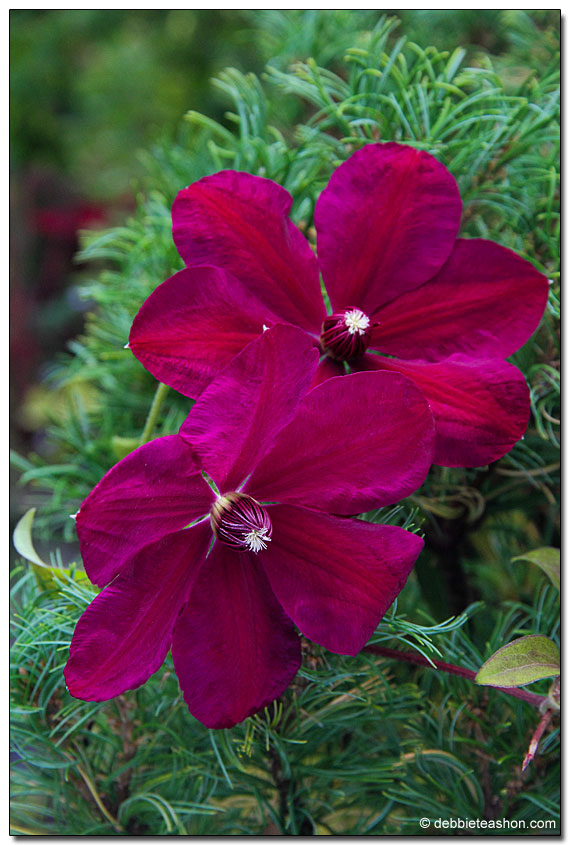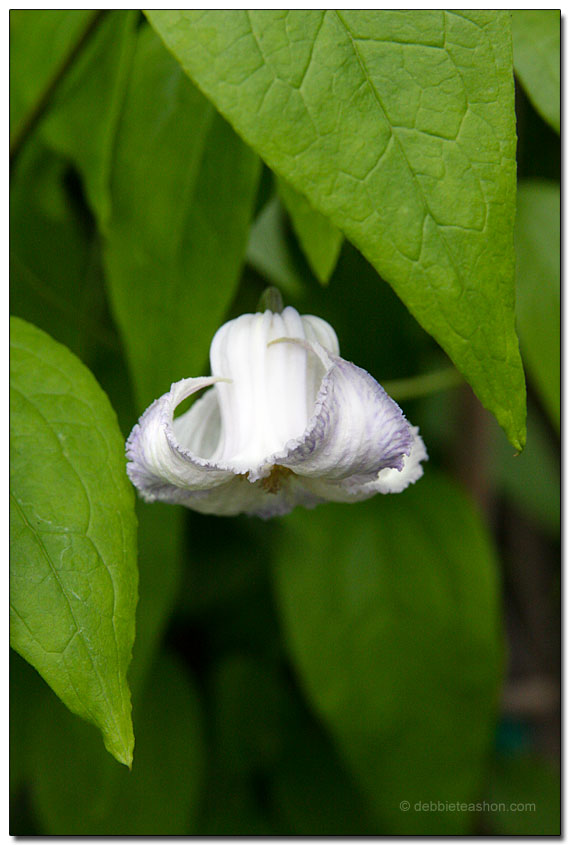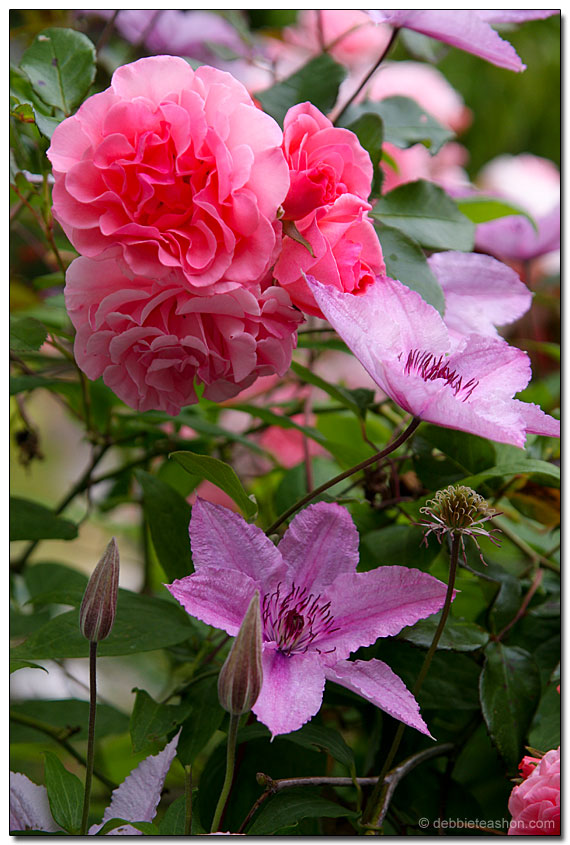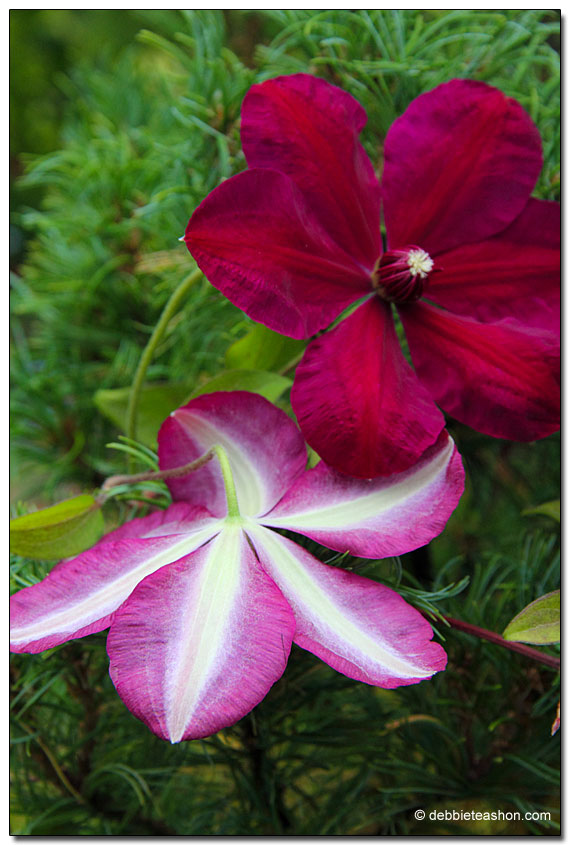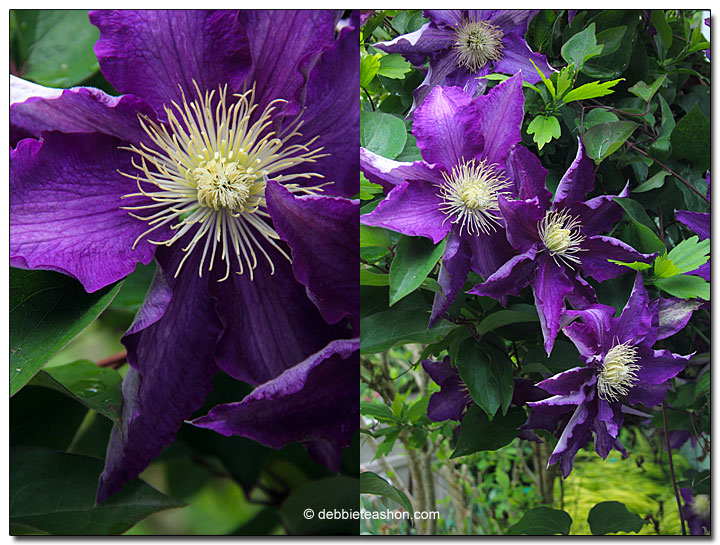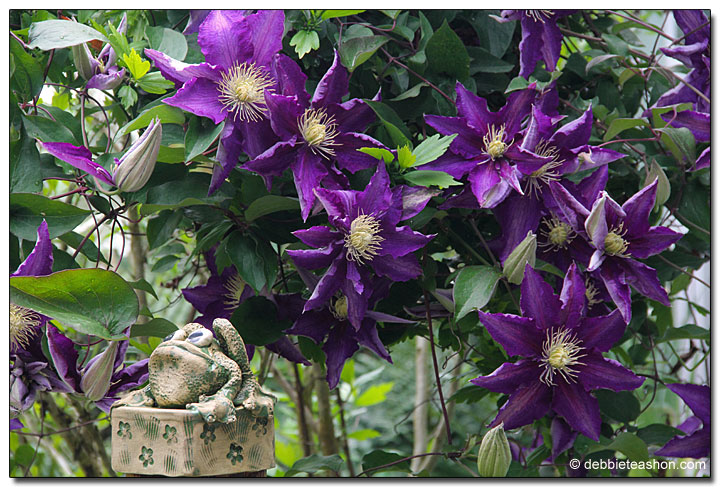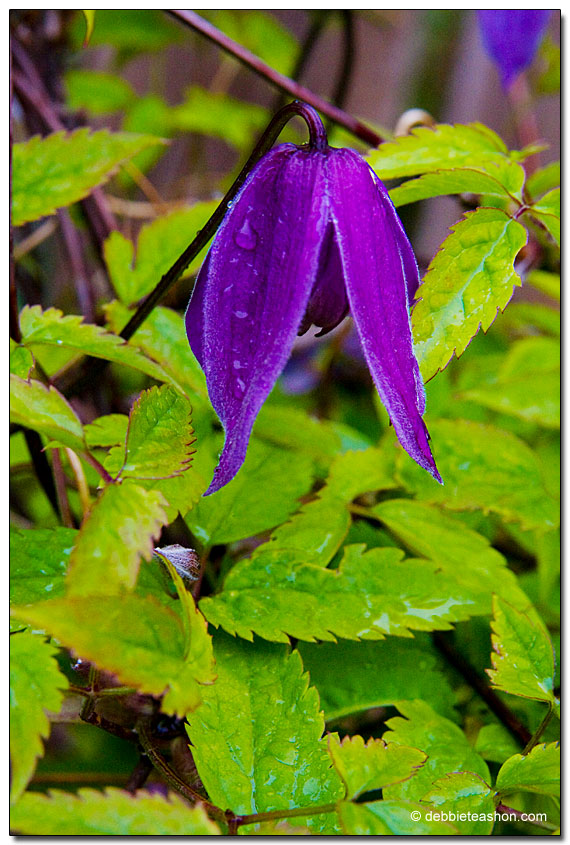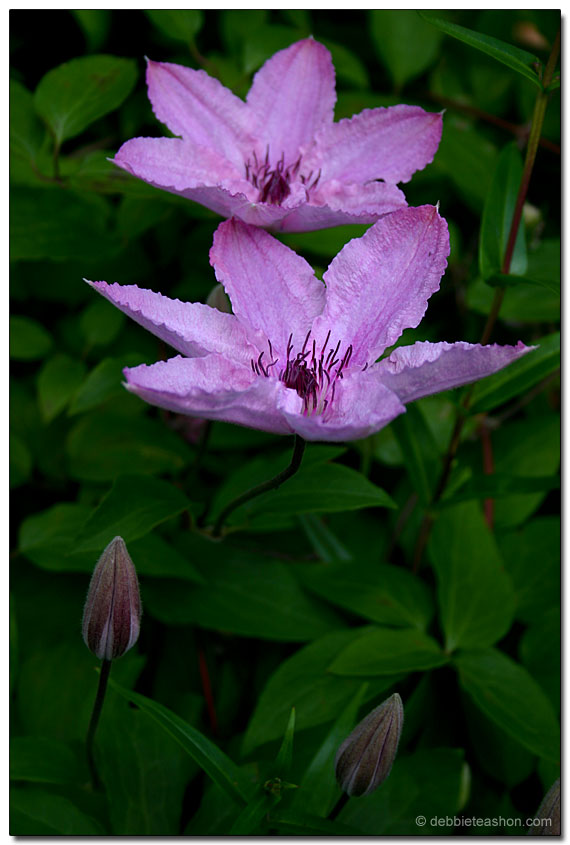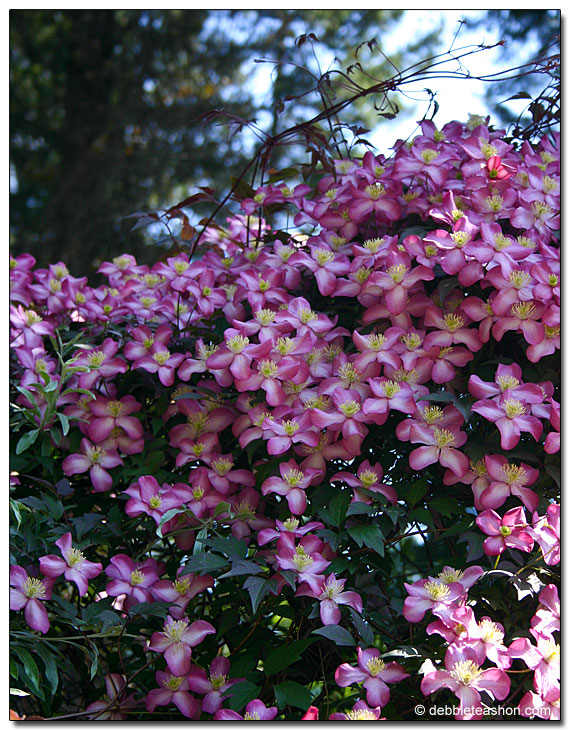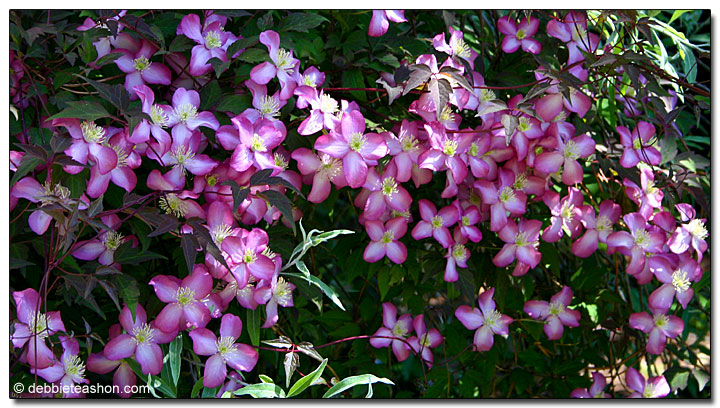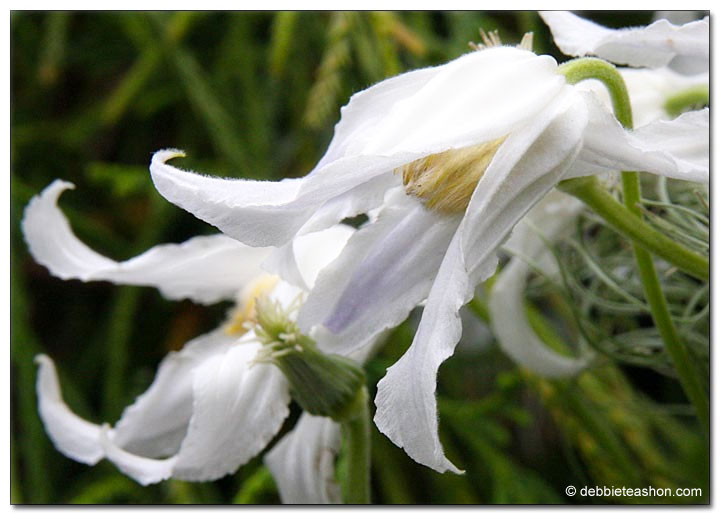When Short on Garden Space, Grow Up with Clematis
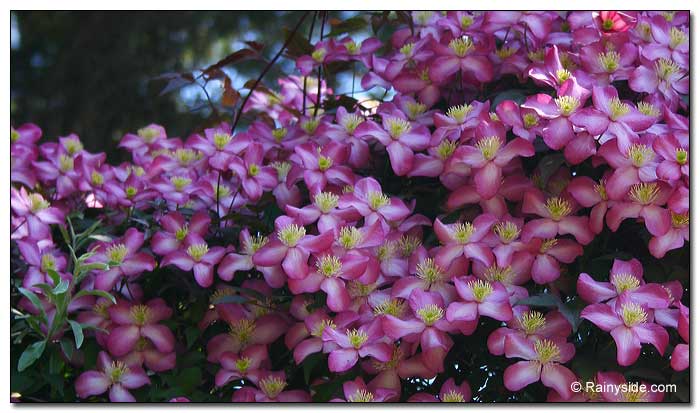
Originally written for West Sound Magazine in 2014.
Smitten by their flowery charms, breeders worldwide introduce cultivars that can fit almost any garden space in a variety of bloom colors and sizes. If you are short on garden space, clematis, the diva of the perennial vines, adds lively impact without taking up too much premium ground space. Be aware; when these divas open their petals in your garden, it is easy to succumb to their allure. You may find yourself covering more uncharted territory with the lovely vines — look up and see all that unused space above.
Clematis ‘Westerplatte’
Even homes without a garden can accommodate clematis in containers filled with the vine’s showy flowers; some clematis are also bred to grow indoors as houseplants. Exciting new breeding work is bringing new varieties for outdoor hanging baskets. You can expect to see them showing up in local nurseries this year and next.
Our maritime climate is well suited for growing clematis. With proper pruning and attention to the vine’s few requirements, almost anyone can grow them on the greater Kitsap Peninsula. At one time, standard recommendations said to keep the roots shaded and cool. You can grow clematis with the sun at its roots; however, adding organic mulch as a side dressing around the roots assists the vines by helping retain moisture, keep weeds down, and builds healthy soil.
Clematis prefer moist, well-drained soil, with pH levels from 6.5 to 6.8 and rich in organic material. The vine will thrive in any garden that provides conditions for the most diverse plant life. The only species that can tolerate intermittent wet roots is Clematis crispa.
Clematis crispa
The plant needs fertilizer during the growing season and copious amounts of water. A monthly feeding of liquid fertilizer or a complete organic fertilizer from March to July gives it the boost it needs for proper growth and strength to flower. Deep watering once a week during the summer drought, or any time there is less than an inch of rain a week, keeps this vine in top shape.
After planting your clematis, don’t be distressed when it appears to grow slowly and doesn’t bloom for the first few years. Below the soil, the plant is sending its energy into establishing a healthy root system. By the third year, the vine rewards your patience and care with substantial growth and vast amounts of blooms for many growing seasons after that.
Clematis ‘Hagley Hybrid’ and Rosa ‘Dreamweaver’ climb together.
With many cultivars to choose from, you can select one that will match the space you have. Some varieties grow only six feet tall, looking delectable and sweet while clambering over shrubs or up to a light post. Imagine yourself sitting under a large arbor where you breathe in the sweet aroma from the pink-flowering Clematis montana ‘Freda’.
Marry together a beautiful shrub or climbing rose with clematis that flower at the same time. Alternatively, select clematis that flower late and a rose that blooms in June. Be sure the shrub or tree is well established and large enough to handle an interloper in its branches before you plant clematis at its feet.
Clematis ‘Hakuòkan’ unfurling flower.
Pruning Methods Demystified
Clematis are divided into three distinctive groups. Knowing what group your vine falls under will guide you on when and how to prune.
No matter the standard pruning recommendations for your newly planted vine, the following March, prune severely down to a leaf bud within one foot to 18 inches above soil level before new growth begins to encourage more branching. The following year, go back to pruning the recommended way for the type of clematis you grow.
Group 1: Early-flowering species and cultivars produce flowers on the previous year’s growth. Minimally prune within a month after it is done blooming, and only when needed to remove damaged or dead wood. You can cut back overgrown shoots to keep them in the bounds of the allotted space.
Group 2: Early, large-flowered cultivar flowers are usually large, single, semi-double or double blossoms. Flowers bloom on both the previous year’s growth and new growth. Keep pruning this group to a minimum. After the first flush of flowers finishes in spring, prune out damaged or dead wood and lightly prune the portions of the vine that bloomed.
Group 3: Late-blooming plants in summer and fall flower on the current season’s growth. Before new growth begins mid-February to March, prune severely down to a leaf bud within one foot to 18 inches above soil level.
Varieties to Grow
‘Luisa’ and ‘Kassia’
Clematis ‘Kassia’
Clematis ‘Luisa’
From the Miniature Clematis Flora Series come two exciting new varieties for hanging baskets and container growing that we should see in local garden centers soon. Ground cover or container culture. No pruning necessary.
‘Westerplatte’
Clematis ‘Westerplatte’
These flowers have overlapping, deep, rich rose-red tepals with recurving tips and red bars down the center. Red stamens and creamy white to yellow anthers offer a beautiful contrast with the flower petals.
Garden or container culture. Height: 6 feet; pruning group 2.
‘Hakuòkan’
Clematis ‘Hakuòkan’
‘Hakuòkan’ translated from Japanese, which means “white royal crown” refers to the striking creamy-white stamens. Flowers have deep, rich, royal purple, single flowers consisting of seven to eight-pointed tepals with creamy-white stamens. Semi-double flowers sometimes occur.
Garden or container culture. Height: 6-8 feet; pruning group 2.
C. alpina ‘Helsingborg’
Clematis ‘Helsingborg’
‘Helsingborg’ flowers are 2-inch long, with deep bluish-purple pointed sepals and purple stamens on nodding, slightly twisted, bell-shaped flowers. Attractive, silky seed heads follow the flowers.
Garden culture. Height: 8-10 feet; pruning group 1.
‘Hagley Hybrid’
Clematis ‘Hagley Hybrid’
The lavender young tepals mature lighter and turn lavender-mauve with red anthers on 3- to 4-inch single flowers. Grow in partial shade to prevent the flowers from fading too quickly.
Garden culture. Height: 8 feet; pruning group 3.
‘Freda’
Clematis montana ‘Freda’
Fragrant, cherry pink, anemone-like flowers have a light pink bar running down the center of each tepal and yellow anthers. New leaf growth has dark purple foliage. This vine is less rampant than other C. montanas — the right choice for smaller gardens.
Garden culture. Height: 13-20 feet; pruning group 1.
‘Hakuree’
Clematis ‘Hakuree’
The gardenia-scented, bell-shaped, nodding flowers have pointed tips, which outwardly recurve. At the cooler end of the growing season, the sepals are bluish-white, and when warm air arrives later in the summer, the sepals are white. This one is not a climber but can lean on other plants or let flop on the ground.
Garden or container culture. Height: 24-30 inches; pruning group 3.
Initially written for the West Sound Magazine, 2014 winter issue.

